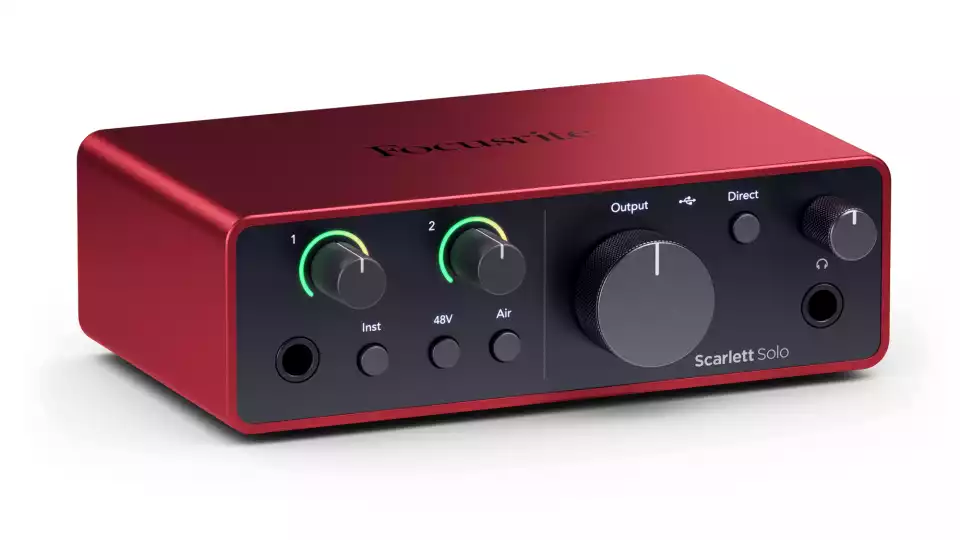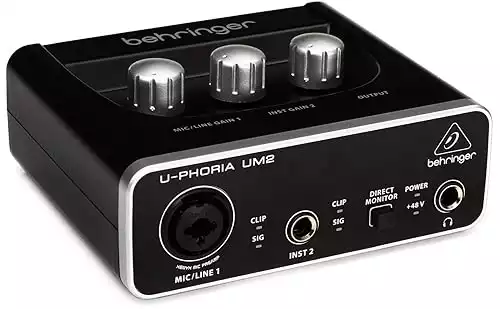If you’re reading this, chances are you’re doing research for your first audio interface. Two of the most popular models are the Focusrite Scarlett Solo and the Behringer UM2. I recommend them as good beginner-level audio interfaces, and so do many others.
The UM2 is simple, inoffensive, and good for the price. But the Scarlett Solo offers more features, higher sound quality, and could be the better buy long-term.
Let’s take a look at both of these interfaces and see which one’s right for you.
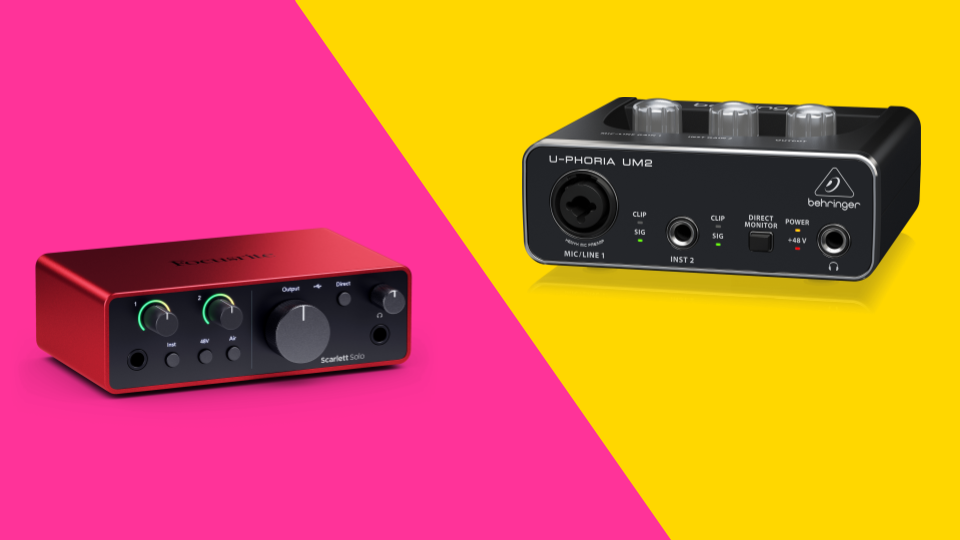
Quick Look: Focusrite Scarlett Solo vs Behringer UM2
Note: This article contains affiliate links. We may earn a commission if you make a purchase, at no additional cost to you.
|
$139.99
|
$59.00
|
|
|
|
|
|
|
|
|
- 1 rear-facing XLR input
- 1 front-facing line input
- 2 line outputs
- 1/4" headphone jack
- Connects via USB-C
- Sample rate: up to 192 kHz
- Bit rate: up to 24-bit
- Recycled aluminum chassis
- Matte black plastic panels
- +48V phantom power
- Direct Monitor for latency-free monitoring
- 2 Air Mode settings — hi-range boost and mid-range boost
- Includes software bundle
- 1 combo XLR/TRS input
- 1 dedicated TRS input
- 2 RCA outputs
- 1/4" headphone jack
- Connects via USB type B
- Sample rate: up to 48 kHz
- Bit rate: up to 16-bit
- All-plastic body
- +48V phantom power
- Direct Monitor for latency-free monitoring
Why Trust Me?
I’m a media composer and audio enthusiast with a decade of experience. The Behringer UM2 was the very first interface I ever bought. Since then, I’ve owned other audio interfaces from Focusrite, Behringer, and other brands. Plus, I’ve spent several years working in music retail learning the ins and outs of many products and brands.
Ease of Use
Both interfaces are essentially plug-and-play devices and require very little setup. And I’d say they’re both equally usable.
But I’d give a slight edge to the Scarlett. All the essential buttons and dials are easily accessible from the front. It’s clean and intuitive.
For some reason, the UM2 has the 48V phantom power switch on the back. It’s a minor inconvenience, but worth pointing out.
Inputs
Both devices are 2-in, 2-out audio interfaces. But there are some slight differences between them.
- XLR Inputs: The Scarlett Solo has one XLR-only input on the back. The UM2 has one combo XLR/line input on the front.
- Instrument/Line Inputs: Each one has a dedicated 1/4-inch input for guitars and other instruments. The Scarlett Solo lets you switch between “line” and “instrument” settings to accommodate different signals like keyboards or guitars.
The Solo and UM2 can both let you record one mic and one instrument at the same time (such as recording yourself singing while playing guitar).
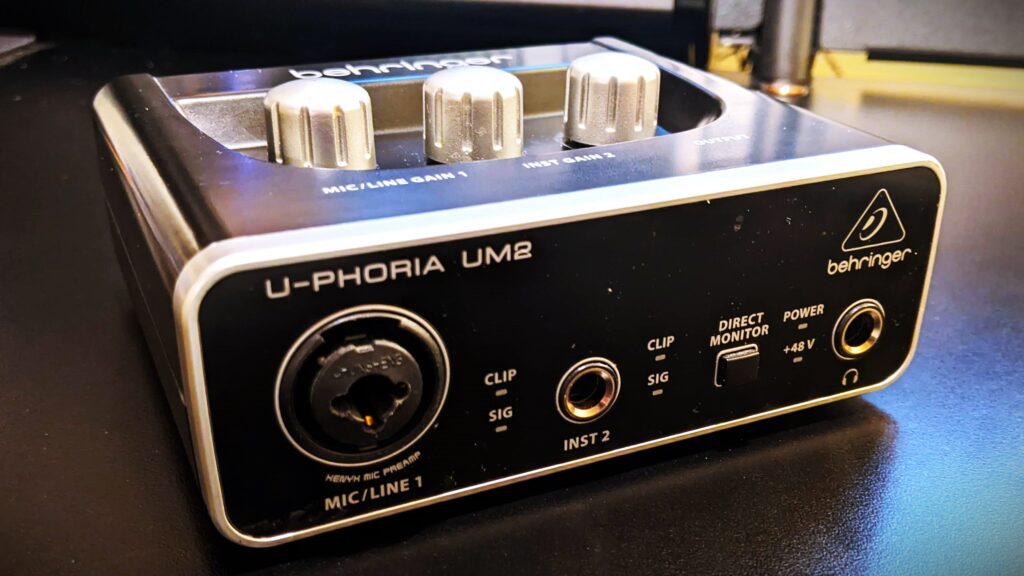
Outputs
Each device uses different output connectors.
- Scarlett Solo: Uses two 1/4-inch line outputs.
- Behringer UM2: Uses two RCA outputs.
Keep that in mind if you’re choosing speakers for these interfaces, or trying to match the interface to your existing setup.
Audio Resolution
4th gen Scarlett devices use RedNet converters, which can record 24-bit/192 kHz audio.
The Behringer UM2 can record 16-bit/48 kHz audio.
In simple terms, the Scarlett can record audio at a much higher quality than the Behringer.
Preamps & Gain Range
The Scarlett Solo’s preamp has an input gain range of 57db. And thanks to Focusrite’s RedNet converters, the signal is clean and doesn’t produce much noise.
That said, the gain range isn’t as high as other Scarlett interfaces like the 2i2 and 4i4. So be aware of that if you plan to use gain-hungry mics like the SM7B.
The Behringer UM2 uses the XENYX preamp. I can’t find any official documentation from Behringer on what sort of gain range it provides. But according to this document from ProSoundOnline, other XENYX devices have a gain range of 60 dB, which puts it on par with the Scarlett.
On paper, that’s good. But from my experience, the UM2 is more prone to static hiss than any Scarlett interface I’ve had. It’s not nearly as good as other Behringer interfaces with the Midas preamps.
Build Quality
Scarlett interfaces have an all-metal outer chassis with an attractive red finish. It feels premium, and will definitely protect everything inside if it ever falls.
The front panel uses a matte black plastic that won’t smudge. The buttons and dials are all rock-solid and don’t wobble at all.
On the other hand, the Behringer UM2 just feels cheap. The entire body is made from lightweight plastic, which bends easily in some places when pressed in.
In fairness, I didn’t feel any wobble when using the dials. I don’t have any major concerns with the UM2’s durability. But I wouldn’t be entirely surprised if it broke when dropped.
Additional Features
In terms of features, the Scarlett Solo handily beats the Behringer UM2.
Both offer direct monitoring for latency-free monitoring. And they each provide 48V phantom power for microphones that need it.
But the Scarlett offers two Air Modes, which are EQ settings that boost certain frequencies:
- Presence — Boosts the high-range of a signal to help it cut through a mix.
- Harmonic Drive — Boosts a signal’s mid-range for more punch and body. It’s especially useful for instrumentals, but vocalists can put it to good use too.
This makes the Scarlett much more versatile than the UM2. You can customize the sound going in rather than “fixing it in post”.
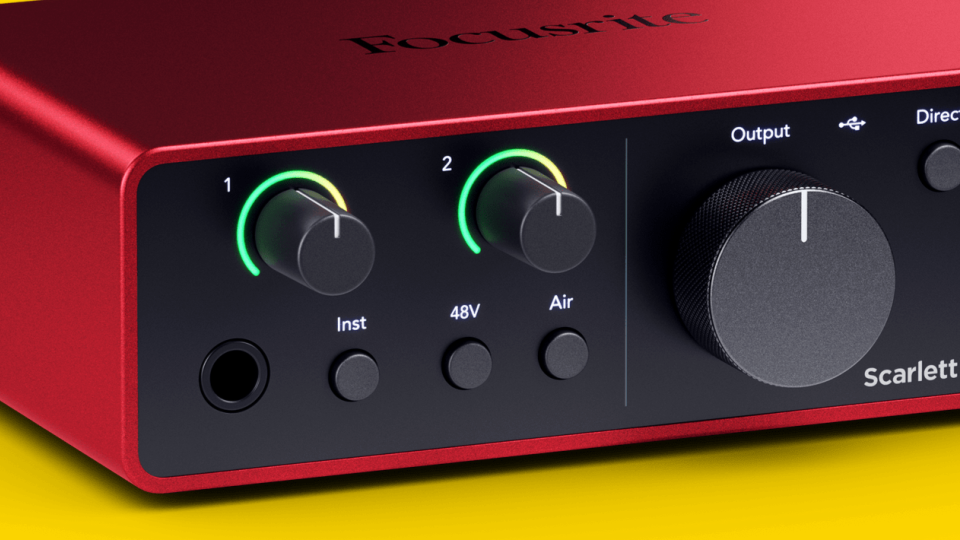
Bundled Software
I’d never recommend getting an interface just for the software. But it can be a nice bonus.
The Behringer UM2 doesn’t come with any software at all. So no bonus there.
But the Scarlett Solo comes with Focusrite’s Hitmaker Expansion bundle. It’s an expansive software package that comes with some DAWs, instruments, plugins, and other subscriptions.
It’s enough to get your home studio off the ground and start producing pro-sounding music right away.
Software Included with the Focusrite Scarlett Solo
DAWs
- Ableton Live Lite
- Pro Tools Artist (3-month subscription)
Mixing, Mastering, and Effects Plugins
- Antares Auto-Tune Access
- Brainworx Bx_console Focusrite SC
- FAST Balancer
- Red 2 & 3 Plug-in Suite
- Relab LX480
- Softube Marshall Silver Jubilee 2555
- Sonnox Vox Doubler
Virtual Instruments
- Native Instruments Massive
- XLN Audio Addictive Keys
- XLN Audio Addictive Drums 2
Subscription Services
- Landr 2-month subscription, plus 5 free masters
- Splice 3-month subscription
In addition to all that free stuff, registered Focusrite customers can get 30% off the FAST Bundle. It’s a suite of AI-powered mixing & FX plugins that help you get pro-sounding results faster.
Who Is Each Device For?
This question is really about two things:
- How dedicated you are to recording high-quality audio.
- How much you’re willing to spend.
With those things in mind, here are some guiding thoughts.
Behringer UM2 — This interface can help you get your recording setup off the ground without spending too much money. Just be aware that you’ll likely want to upgrade further down the line.
Scarlett Solo — If you take your craft seriously and want an interface that lasts, go with the Solo. It can record higher-quality audio, has a better build quality, and comes with a pretty hefty software bundle.
Which Device Is the Best Overall Value?
For me, the clear winner is the Focusrite Scarlett Solo. Even though it’s over twice the cost, it’s a much better long-term value.
You’re getting a versatile interface with more features that can deliver better-sounding audio. It’s also clearly made to last a lifetime thanks to its build quality.
The included software is also an incredibly nice bonus.
An incredibly robust and versatile audio interface for solo musicians and creators. The Scarlett Solo comes with 1 XLR input and 1 line/instrument input. It's small, has a rugged build, and can record audio with pristine quality.
- Rugged build quality
- Improved RedNet circuitry for hi-fidelity audio
- 2 Air Mode settings — hi-range boost and mid-range boost
- Includes software bundle
- Preamp gain could be higher
- Lacks features from other 4th gen Scarlett devices
Compare the Scarlett Series Interfaces
If you’re interested in the Scarlett Solo, you’ll also want to check out the Focusrite Scarlett 2i2. We’ve put together this guide to help you compare the differences between the 2i2 and the Solo.
Research for this article came from personal experience, and from the following sources:
